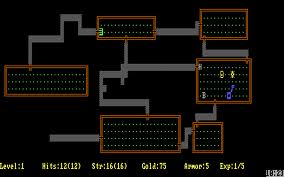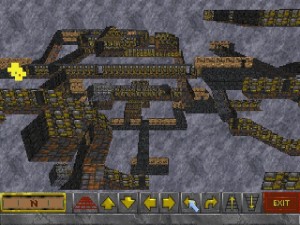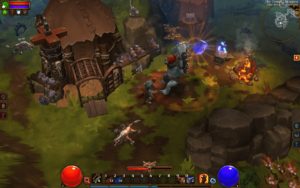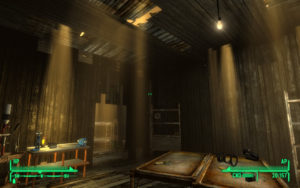RPG Design: Letting the Bots Fill In the Details
Posted by Rampant Coyote on February 24, 2017
 Procedural content generation (PCG) is what will save computer role-playing games, if it doesn’t kill it first.
Procedural content generation (PCG) is what will save computer role-playing games, if it doesn’t kill it first.
What I mean is this:
RPGs are really, really content-heavy. Exploration is a major element in classic RPGs (although, as Guido Henkel recently pointed out, the dice-and-paper tradition they are based on is more oriented on problem-solving). This means the rate of consumption of new (to the player) content is really high – they always have to be visiting new places, seeing new things, finding new discoveries, gaining new equipment, facing new foes.
This makes RPG development really expensive. Prohibitively so, in many cases. There are so many fronts where RPG design should explore, but every single game is playing catch-up with content expectations. Designers have to conceive it, programmers have to support it, and artists and level designers need to build it.
So you are left with two general approaches:
The first approach is to still lovingly hand-craft all the content in the game, which again, reaches into the realm of prohibitively expensive. It’s a lot of time and effort. Tons of resources spent for every hour of player involvement. There are ways of reducing that workload, of course. Using tiles and other highly modularized, reusable pieces that can be rearranged in different configurations can make a huge difference. But it’s still pretty labor intensive… just ask the people putting out the *quality* RPG Maker or similar games. That stuff takes a lot of time and testing.
Even with smart strategies, hand-crafted content takes so much time and effort that a developer can easily spend most of their time just playing catch-up with player expectations. While that’s doable, now and in the future, it leads developers abandoning the field when these expensive, big games fail to break even.
 Another approach is to procedurally generate the content. This one sounds like magic… wave your magic algorithm around, and voilà! Infinite content! Except… the algorithms aren’t magic. They take tons of effort to produce anything that makes something remotely playable or interesting. And as much as I love a good roguelike, even the best procedural generation systems (the kind that take much more time to create than any two maps would have) produce stuff that eventually feels very canned, similar, and predictable. It robs from the feeling of discovery, because “discovering” computer generated content is about like discovering an interesting crack in the pavement. Curious, but pointless.
Another approach is to procedurally generate the content. This one sounds like magic… wave your magic algorithm around, and voilà! Infinite content! Except… the algorithms aren’t magic. They take tons of effort to produce anything that makes something remotely playable or interesting. And as much as I love a good roguelike, even the best procedural generation systems (the kind that take much more time to create than any two maps would have) produce stuff that eventually feels very canned, similar, and predictable. It robs from the feeling of discovery, because “discovering” computer generated content is about like discovering an interesting crack in the pavement. Curious, but pointless.
Again, I love a good roguelike, or a good Diablo-like, but too much procedural generation yields to boredom, and a game should not be boring! Too much of that, and the whole genre is choked on relatively boring, grindy, computer-generated content.
Which leads me to the point here… we need a blend. An intelligent blend. Across the board. The sort of things that every RPG needs. This is hardly new. Even back in the early tabletop RPG games, we had random tables to help generate content, either to prepare for a game, or to generate events or answers to questions in-game.
While lots of games do this already, I see a more extensive use of this as being the future of computer RPGs. It can happen a few different ways.
 One – it can be used to supplement custom content. We commonly see it now in roguelikes and the like by having custom areas, encounters, and events “seeded” into the procedurally generated landscape. Remember The Butcher in Diablo 1? Yeah, like that.
One – it can be used to supplement custom content. We commonly see it now in roguelikes and the like by having custom areas, encounters, and events “seeded” into the procedurally generated landscape. Remember The Butcher in Diablo 1? Yeah, like that.
Another option: Procedurally generate content at development time, and then customize it. I’ve done this several times for dice & paper games, using either the old tables from the Dungeon Master’s Guide, or online map-generators. These can spark creativity and do some of the “heavy lifting” building the basic content as a foundation for the designer to build on. This is happening in a lot of smaller areas, like procedurally-generated textures, but I don’t know how much it’s getting used in the industry as a tool.
 A third option could be done either at development time or in real-time… have procedural content generation supplement human-generated content. I suspect that’s the kind of thing we’re seeing in Bethesda’s RPGs (post-Daggerfall). Procedural generation can stock the cupboards and treasure chests, populate the countryside with monsters, and even generate some of the less important dungeons or generate grindy little filler quests. The core content is human-generated with that natural feel, but the computer adds the details… which can often be the most annoying and time consuming part to fill in.
A third option could be done either at development time or in real-time… have procedural content generation supplement human-generated content. I suspect that’s the kind of thing we’re seeing in Bethesda’s RPGs (post-Daggerfall). Procedural generation can stock the cupboards and treasure chests, populate the countryside with monsters, and even generate some of the less important dungeons or generate grindy little filler quests. The core content is human-generated with that natural feel, but the computer adds the details… which can often be the most annoying and time consuming part to fill in.
Of course, there’s always the sort of thing we’ve had from the beginning… random loot tables and the occasional random encounter. Things to shake things up a bit and keep them from being too predictable. This can be taken a lot further, like the AI director in Left 4 Dead that generated equipment and encounters based on dramatic pacing. Or randomness. Sometimes it’s hard to tell.
In the end… there’s a whole spectrum between completely hand-generated adventures and the fully procedurally-generated “roguelike.” I think the solution to having rich content that pushes some interesting new approaches to the genre may lay in-between. I think the future lay not in deciding whether or not procedural generation will be used, but more in deciding how much and where.
Filed Under: Game Development - Comments: 2 Comments to Read
Weekly Links #159: tooling edition « No Time To Play said,
[…] more general game design news, we have an article about blending procedural generation with handcrafted content, and another about basing a game in real-world history. And for an announcement I can’t […]
Ayrik said,
I really liked this blog post, thank you for writing it 🙂